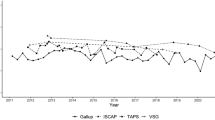Abstract
Multivariate predictions of party identification have been based on father's party and social or demographic characteristics in past studies. This paper uses two policy attitudes to predict party along with the usual predictors of partisanship, from 1956 to 1980. The policy attitudes—domestic welfare policy opinion and civil rights policy opinion—have theoretical links to partisanship stemming from the New Deal and the 1960s. Domestic welfare policy opinion is found to be a major predictor of party identification. Despite the inclusion of the two policy attitudes and correction for attenuation caused by measurement error, only about 50% of the variance in party identification can be explained.
Similar content being viewed by others
References
Achen, Christopher S. (1975), “Mass Political Attitudes and the Survey Response.”American Political Science Review 69:1218–1231.
Beck, Paul Allen (1977). “Partisan Dealignment and the Postwar South.”American Political Science Review 71:477–496.
Berelson, Bernard, Paul Lazarsfeld, and William McPhee. (1954).Voting: A Study of Opinion Formation in a Presidential Election. Chicago: University of Chicago Press.
Burnham, Walter Dean (1968). “American Voting Behavior and the 1964 Election.”Midwest Journal of Political Science 12:1–40.
Campbell, Angus et al. (1964).The American Voter, abridged version. New York: John Wiley.
Campbell, Bruce (1977). “Change in the Southern Electorate.”American Journal of Political Science 21:37–64.
Converse, Philip E. (1964). “The Nature of Mass Belief Systems in Mass Publics.” In David Apter (ed.),Ideology and Discontent. New York: Free Press.
—— (1966a). “The Concept of a Normal Vote.” In Angus Campbell and others (eds.),Elections and the Political Order. New York: John Wiley.
—— (1966b). “On the Possibility of Major Political Realignment in the South.” In Angus Campbell and others (eds.),Elections and the Political Order. New York: John Wiley.
—— (1974). “Comment.”American Political Science Review 68:650–660.
Converse, Philip E., and Gregory B. Markus (1979). “Plus ca change.... The New CPS Election Study Panel.”American Political Science Review 73:1055–1070.
Declercq, Eugene, Thomas L. Hurley, and Normal R. Luttbeg (1975). “Voting in American Presidential Elections: 1956–72.”American Politics Quarterly 3:222–246.
Erikson, Robert S. (1979). “The SRC Panel Data and Mass Political Attitudes.”British Journal of Political Science 9:89–114.
-- (1982). “The ‘Uncorrelated Errors’ Approach to Estimating Causal Feedback.”Journal of Politics (in press).
Goldberg, Arthur S. (1966). “Discerning a Causal Pattern among Data on Voting Behavior.”American Political Science Review 50:913–922.
Heise, David R. (1969). “Separating Reliability and Stability in Test-Retest Correlation.”American Sociological Review 34:93–101.
—— (1972). “Employing Nominal Variables, Induced Variables, and Block Variables in Path Analyses.”Sociological Methods and Research 1:147–173.
Jackson, John E. (1975). “Issues, Party Choices, and Presidential Votes.”American Journal of Political Science 19:161–185.
Jencks, Christopher (1972).Inequality: A Reassessment of the Effect of Family and Schooling in America. New York: Basic Books.
Jennings, M. Kent, and Richard G. Niemi (1974).The Political Character of Adolescence. Princeton, N.J.: Princeton University Press.
Knoke, David (1976).Change and Continuity in American Politics: The Social Bases of Political Parties. Baltimore: Johns Hopkins.
Knoke, David, and Michael Hout (1974). “Social and Demographic Factors in American Political Party Affiliation, 1952–72.”American Sociological Review 39:700–713.
Lazarsfeld, Paul F., Bernard Berelson, and Hazel Gaudet. (1948).The People's Choice. New York: Columbia University Press.
Miller, Author H. (1978). “Partisanship Reinstated? A Comparison of the 1972 and 1976 U. S. Presidential Elections.”British Journal of Political Science 8:129–152.
Page, Benjamin, and Calvin Jones. (1979). “Reciprocal Effects of Policy Preferences, Party Loyalties and the Vote.”American Political Science Review 73:1071–1089.
Pierce, John C., and Douglas, D. Rose (1974). “Nonattitudes and American Public Opinion: The Examination of a Thesis.”American Political Science Review 68:626–649.
Pomper, Gerald M. (1972). “From Confusion to Clarity: Issues and American Voters, 1956–1968.”American Political Science Review 66:415–428.
Schulman, Mark A., and Gerald M. Pomper (1975). “Variability in Electoral Behavior: Longitudinal Perspectives from Causal Modeling.”American Journal of Political Science 19:1–18.
Siegel, Paul M., and Robert W. Hodge (1968). “A Causal Approach to the Study of Measurement Error.” In Hubert M. Blalock, Jr., and Ann B. Blalock (eds.),Methodology in Social Research. New York: McGraw-Hill.
Wiley, David E., and James A. Wiley (1970). “The Estimation of Measurement Error in Panel Data.”American Sociological Review 35:112–117.
Author information
Authors and Affiliations
Rights and permissions
About this article
Cite this article
Cassel, C.A. Predicting party identification, 1956–80: Who are the republicans and who are the democrats?. Polit Behav 4, 265–282 (1982). https://doi.org/10.1007/BF00990108
Issue Date:
DOI: https://doi.org/10.1007/BF00990108




